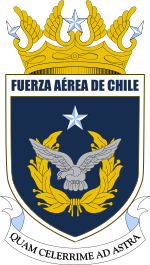|
Chilean Air Force
The Chilean Air Force (Spanish: Fuerza Aérea de Chile (FACh) is the air force of Chile and branch of the Chilean military. HistoryThe first step towards the current FACh is taken by Teniente Coronel training as a pilot[citation needed] in France. Although a local academy was created, the first officers were sent to France for their training as well. One of them, Captain Manuel Ávalos Prado, took command over the Chilean military aviation school, which was officially established in February 1913, and remained in command until 1915. The Military Aviation School (Escuela de Aviación Militar) was named in honor of him in 1944, and still carries that name today. In those early years many aviation milestones were achieved; conquering the height of the Andes was one of the main targets as well as long distance flights. Typical aircraft of that era were Avro 504, Bleriot XI, Bristol M.1C, DH.9, and SE5a. In the following decade, the Airmail Line of Chile (Línea Aeropostal de Chile) was created on 5 March 1929 as a branch of the military aviation. This postal airline later developed into the National Airline (Línea Aérea Nacional) that is still the leading airline in Chile today. Shortly afterwards, on 21 March 1930, the existing aviation elements of the army and navy were amalgamated into a dedicated department: the Department of the Air Force (Subsecretaria de Aviación) effectively creating the current independent Air Force. It was initially named National Air Force (Fuerza Aérea Nacional). The international airport of Chile carries the name of Lan's founding father and first commander of the air force, Air Commodore Arturo Merino Benítez. Its baptism of fire was in the 1931 sailors' rebellion in Coquimbo, where Air Force attack aircraft and bombers and 2 transport planes converted into bombers contributed to its failure. The first outlines of the organization of the current air force were visible in 1945 with the inception of Transport Group 1, later renumbered Group 10, with two C-45s and a single T-6 Texan at Los Cerrillos. Two years later the first FACh flight to Antarctica was performed. The fifties meant entry into the jet age for the FACh, and Grupo 7 was the first unit to receive them in 1954. Chile got its aircraft from both the United States and Europe. The American supply consisted of Lockheed F-80, Lockheed T-33, Beech T-34 Mentor, Cessna T-37, Cessna A-37 Dragonfly and Northrop F-5E/F for example, whereas the British supplied Hawker Hunters and the French delivered various helicopters and Dassault Mirage 50 aircraft. During the military coup d'état on September 11, 1973, the Chilean Air Force conducted Operation Silence, Hunters from the 7th Aviation Squadron destroyed several transmission antennas belonging to pro-government radio stations. After accomplishing their mission, the aircraft performed attack runs on the presidential residence at Las Condes and the presidential palace, a pilot mistakenly opened fire on the Air Force Hospital when attacking the residence, no casualties were reported. The Chilean air force hosted the joint exercise Salitre with other friendly nations in 2014.[2] It also participated in several United Nations peacekeeping missions overseas in 5 occasions. The Chilean Air Force reported one of its C-130 Hercules transport aircraft carrying 38 people en route to Antarctica missing on December 9, 2019. The aircraft was on its way to Antarctica’s King George Island to provide logistic support to a military base when radio contact was lost.[3] On 11 December 2019, aircraft debris was located 18 miles South of where the plane last made contact and no survivors were found. The cause of the crash is unknown.[4] Commanders-in-chiefOrder of battlePersonnel = 10,600 (including 700 conscripts)[citation needed] Office of the Commander in Chief Combat Command of the Air Force First Air Brigade with headquarters in Los Cóndores Air Base (Base Aérea Los Cóndores) in Iquique
Second Air Brigade with headquarters in Pudahuel Air Base (Base Aérea Pudahuel) in Santiago
Third Air Brigade with headquarters in El Tepual Air Base (Base Aérea El Tepual) in Puerto Montt
Fourth Air Brigade with headquarters in Chabunco Air Base (Base Aérea Chabunco) in Punta Arenas

Fifth Air Brigade with headquarters in Cerro Moreno Air Base (Base Aérea Cerro Moreno) in Antofagasta
Personnel CommandEducation Division
Health Division Logistics CommandMaintenance Division The Air Force also maintains the Air Force Special Forces (Comandos de Aviación), comparable to a United States Air Force Combat Control Team.[citation needed] They may be up to 350 strong, and their roles include assault, reconnaissance, Air Traffic Control, Fire Support, and Command, control, and communications.[citation needed] AircraftAircraftCurrent inventory      Industry Chile also maintains its own aviation industry, ENAER. The design of the T-35 Pillán trainer, based on the Piper PA-28R Saratoga, is the best known example, seeing some export success as well. Furthermore, the assembly of the A-36/T-36 Halcón (CASA C-101) was achieved as well. Performing maintenance on most types in the current inventory, such as minor modifications on F-5E aircraft for example, the industry is of significant importance to the air force. ENAER is reported to be in talks with Embraer of Brazil to codesign the first indigenous South American military transport plane. Also, under the Pacer Amstel programme, with initial Dutch support, and later locally ENAER upgraded an F-16 combat jet, which for the Chilean Air Force is an advance for their maintenance of the F-16 fleet (becoming the 5th country to modify their jets under authorization). Ranks
BadgesOfficers
Non-commissioned officers and airmen
Officers' cap badgesChilean Air Force officers wear the following cap badges in their peaked caps.
Notes
BibliographyExternal linksWikimedia Commons has media related to Fuerza Aérea de Chile.
|
|||||||||||||||||||||||||||||||||||||||||||||||||||||||||||||||||||||||||||||||||||||||||||||||||||||||||||||||||||||||||||||||||||||||||||||||||||||||||||||||||||||||||||||||||||||||||||||||||||||||||||||||||||||||||||||||||||||||||||||||||||||||||||||||||||||||||||||||||||||||||||||||||||||||||||||||||||||||||||||||||||||||||||||||||||||||||||||||||||||||||||||||||||


























